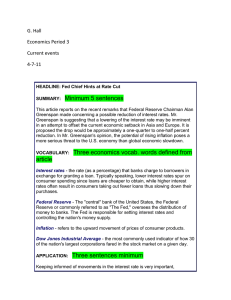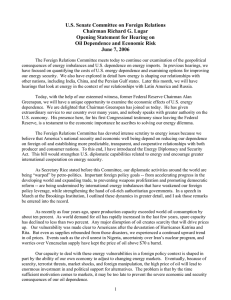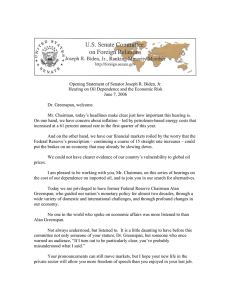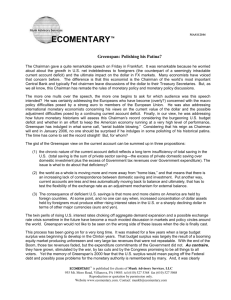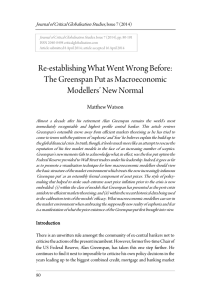521
advertisement
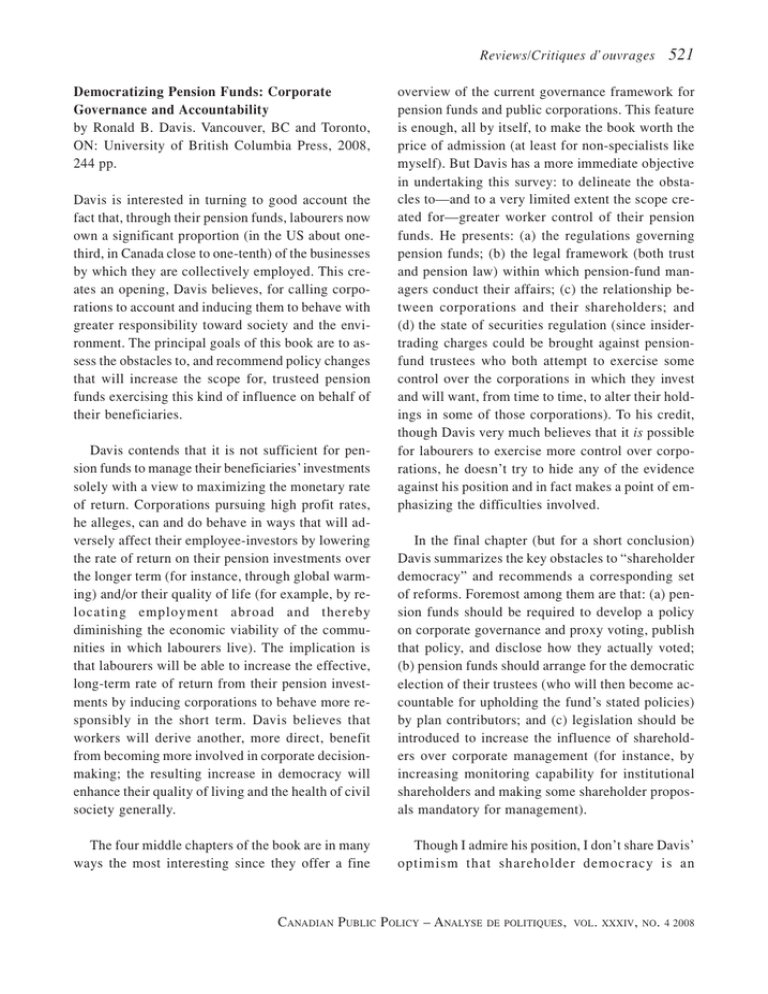
Reviews/Critiques d’ouvrages Democratizing Pension Funds: Corporate Governance and Accountability by Ronald B. Davis. Vancouver, BC and Toronto, ON: University of British Columbia Press, 2008, 244 pp. Davis is interested in turning to good account the fact that, through their pension funds, labourers now own a significant proportion (in the US about onethird, in Canada close to one-tenth) of the businesses by which they are collectively employed. This creates an opening, Davis believes, for calling corporations to account and inducing them to behave with greater responsibility toward society and the environment. The principal goals of this book are to assess the obstacles to, and recommend policy changes that will increase the scope for, trusteed pension funds exercising this kind of influence on behalf of their beneficiaries. Davis contends that it is not sufficient for pension funds to manage their beneficiaries’ investments solely with a view to maximizing the monetary rate of return. Corporations pursuing high profit rates, he alleges, can and do behave in ways that will adversely affect their employee-investors by lowering the rate of return on their pension investments over the longer term (for instance, through global warming) and/or their quality of life (for example, by relocating employment abroad and thereby diminishing the economic viability of the communities in which labourers live). The implication is that labourers will be able to increase the effective, long-term rate of return from their pension investments by inducing corporations to behave more responsibly in the short term. Davis believes that workers will derive another, more direct, benefit from becoming more involved in corporate decisionmaking; the resulting increase in democracy will enhance their quality of living and the health of civil society generally. The four middle chapters of the book are in many ways the most interesting since they offer a fine 521 overview of the current governance framework for pension funds and public corporations. This feature is enough, all by itself, to make the book worth the price of admission (at least for non-specialists like myself). But Davis has a more immediate objective in undertaking this survey: to delineate the obstacles to—and to a very limited extent the scope created for—greater worker control of their pension funds. He presents: (a) the regulations governing pension funds; (b) the legal framework (both trust and pension law) within which pension-fund managers conduct their affairs; (c) the relationship between corporations and their shareholders; and (d) the state of securities regulation (since insidertrading charges could be brought against pensionfund trustees who both attempt to exercise some control over the corporations in which they invest and will want, from time to time, to alter their holdings in some of those corporations). To his credit, though Davis very much believes that it is possible for labourers to exercise more control over corporations, he doesn’t try to hide any of the evidence against his position and in fact makes a point of emphasizing the difficulties involved. In the final chapter (but for a short conclusion) Davis summarizes the key obstacles to “shareholder democracy” and recommends a corresponding set of reforms. Foremost among them are that: (a) pension funds should be required to develop a policy on corporate governance and proxy voting, publish that policy, and disclose how they actually voted; (b) pension funds should arrange for the democratic election of their trustees (who will then become accountable for upholding the fund’s stated policies) by plan contributors; and (c) legislation should be introduced to increase the influence of shareholders over corporate management (for instance, by increasing monitoring capability for institutional shareholders and making some shareholder proposals mandatory for management). Though I admire his position, I don’t share Davis’ optimism that shareholder democracy is an CANADIAN PUBLIC POLICY – ANALYSE DE POLITIQUES, VOL . XXXIV, NO. 4 2008 522 Reviews/Critiques d’ouvrages attainable goal. The principal impediments are ones that Davis himself fully acknowledges: “rational apathy” on the part of pension-plan contributors, a penchant by employers to treat pension funds as their property and not something that ought to be subject to control by their employees, a pension-fund industry that has a comfortable arrangement with corporations that it doesn’t want to see disturbed, and the very weak influence that shareholder votes have over corporate boards of directors. Even if by some miracle all of these obstacles could be overcome, it isn’t clear how much further ahead we would be. As one scholar quoted by Davis (p. 142) comments: “It strikes me as stupendously naive to expect that the common shareholders, if only we would restore them to a position of electoral control over management, would exorcise whatever shady practices have been lining their pockets” (Stone 1986). Even non-shady practices would pose a problem. Would a majority of plan contributors, for instance, approve of keeping in operation a factory by which only some of them were employed, even though that factory was CANADIAN PUBLIC POLICY – ANALYSE DE POLITIQUES, a clear drain on the fund’s overall rate of return? Nor is it clear that pension-plan owners would find it easy to agree on the operational meaning of “environmental responsibility” for a given corporation; tensions would be sure to emerge between those who believed very firmly in the reality of global warming and those who worried that a shareholder proposal to reduce the carbon footprint of their investment portfolio would needlessly diminish their post-retirement standard of living. But I agree with Davis all the same that as a society we would be better off if all of us, in our capacity as employees, were required from time to time to think about questions like this and discuss them intelligently in a public forum. REFERENCE Stone, C. 1986. “Corporate Social Responsibility: What it Might Mean, if it Were to Really Matter.” Iowa Law Review 71:558. RICHARD A. KLEER, Department of Economics, University of Regina VOL . XXXIV , NO. 4 2008 Reviews/Critiques d’ouvrages The Age of Turbulence: Adventures in a New World by Alan Greenspan. London: Penguin Press, 2008, 563 pp. At a reception recently, I was asked by a member of my university’s governing board: “So you teach economics. Tell me, what makes an economy grow and prosper?” I suggested that he read Alan Greenspan’s memoir The Age of Turbulence: Adventures in a New World. Greenspan is well placed to provide insight into the determinants of economic growth, having served as chair of the US Federal Reserve Board (the Fed) from 1987–2006, and as chair of the Council of Economic Advisors under President Ford. His book is engaging, readable, and provides fascinating snapshots of US and international policymakers over the last four decades. As well, the recently released paperback edition of the book includes an epilogue which discusses the current financial crisis in the US. With its international scope, the book will be of interest to readers beyond the US, but particularly in Canada, given that the Canadian economy is so closely linked to the US economy. The Washington Post journalist Bob Woodward describes Greenspan’s style as “intellectual engagement tempered by emotional detachment” and this approach is used to great advantage in the book. Its depth of analysis and attention to detail reveal Greenspan’s intellectual curiosity about how economies function and the growing impact of globalization. While he was often a central player in policy debates, Greenspan remains “detached” in the best sense of the word. He simply outlines the (numerous) facts as he observes them and explains how his thinking evolved. In the last half of the book, Greenspan ignores Mark Twain’s warning that it is dangerous to make predictions, especially about the future. He provides knowledgeable and sometimes surprising opinions on trends and potential trouble spots in the world economy over the next two decades. An underlying theme of Greenspan’s book is that, if a nation wants to promote growth, it is crucial 523 that it provide legal protection of private property rights. He notes that it was always an embarrassment to the Soviet Union’s central planners that a very substantial percentage of its crops came from “private” plots that covered only a small fraction of tilled land. Another vital driver of growth is competition. While acknowledging on an intellectual level that competition spurs productivity, Greenspan does not claim to like it on a personal level. He concedes that he never thought kindly of rival firms that sought to lure clients from his economic consulting firm Townsend-Greenspan, and he doubts that IBM was thrilled to see computerized word processors upstage the venerable Selectric typewriter. According to Greenspan, capitalism creates a tug-of-war within us—we are alternately the aggressive entrepreneur and the couch potato who prefers the lessened competitive stress of an economy where everyone has equal income. Included in the book are concise and insightful chapters on the successes and challenges faced by China, Russia, Latin America, and India. One of the most fascinating chapters is on the long-term energy squeeze. Greenspan notes that the roots of today’s high oil prices go back at least two decades, during which time world oil consumption has been rising at twice the rate of oil production capacity. Why did this happen? Three-quarters of the world’s energy reserves are in OPEC countries, and all OPEC oil reserves are owned or controlled by state monopolies. Oil revenues are a principal source of government revenues, and almost all of the OPEC national oil monopolies have professed no desire to contain oil-price increases by expanding crude-oil capacity. In developed countries, even considering unconventional sources such as Canada’s oil sands, additions to reserves have simply not kept pace with oil extraction. As a participant in US political debates from the early 1970s, Greenspan describes the priorities and approaches of different administrations, and how these affected the Fed’s monetary policy maneuver- CANADIAN PUBLIC POLICY – ANALYSE DE POLITIQUES, VOL . XXXIV, NO. 4 2008 524 Reviews/Critiques d’ouvrages ability. He was in favour of President Carter’s growth-promoting initiatives to deregulate airlines, telecommunications, and other industries, but thought Carter received little political credit for them. Greenspan attributes this to Carter’s style, which made change seem like something you did because you had no choice, in contrast to President Reagan who could present economic renewal stirringly. Greenspan and President Clinton agreed that productivity improvements that created dot-com millionaires also caused more inequality, and both were interested in ways to get more of the new wealth into the hands of the middle class. The saxophone was not the only thing they had in common (Greenspan had been a professional sax player in the 1940s). Greenspan reveals some admiration for Clinton, and the view was evidently reciprocated since, in a somewhat unusual move in US politics, Clinton reappointed him as Fed chair even though Greenspan is a Republican. The US Federal Reserve is charged with control of US inflation, and inflation was generally low and economic growth strong during Greenspan’s tenure as chair of the Fed. The chief factor Greenspan credits for this is control of the government deficit under President Clinton. Reducing the deficit was a policy he espoused, and it allowed interest rates to fall and long-term inflation expectations to decline. Greenspan also admits that he was lucky to have help from global factors. In particular, the increased involvement in world trade of Eastern Europe, China, and India—with their vast labour forces— helped expand world output and slow price inflation. This process will eventually end. How high is inflation likely to go at that point? Greenspan notes that the Fed chair faces considerable pressure from politicians to keep interest rates low. He notes that: “During my 18-and-a-half-year tenure, I cannot remember many calls from presidents or Capitol Hill for the Fed to raise interest rates. In fact, I believe CANADIAN PUBLIC POLICY – ANALYSE DE POLITIQUES, there was [sic] none” (p. 478). Counterbalancing the political pressure for low interest rates (which may lead to inflation), an inflation rate close to double digits can also create a political storm. Richard Nixon felt the political need to impose wage and price controls in 1971, even though the inflation rate was below five percent. For this reason, Greenspan views the 4.5 percent average inflation rate over the half-century since the abandonment of the gold standard as a good first approximation of what to expect. Any reader planning to retire on a noninflation indexed pension might want to take note of this number, as it implies purchasing power shrinks by half in just 15 years. In the epilogue, Greenspan gives his views on the current financial crisis, which he sees as a rare, once in a century or half-century, event. He recommends formal procedures to limit bailouts that employ taxpayer money. He also argues that bailouts should be handled directly and transparently by the US Department of the Treasury in a fashion similar to that employed to deal with the savings and loan (S&L) crisis of the 1980s. This is preferable to a circuitous route through the central bank, as was done with Bear Stearns, since if the Fed experiences loan losses, this could hinder its ability to implement monetary policy and control inflation. Greenspan also argues that while the current crisis may require official intervention, particularly in terms of the prosecution of fraud, for the US economy to rebound quickly it must not become encumbered by protectionism or excessive regulation that limit flexibility. Economic flexibility, which allows individuals to seize new opportunities as they arise, is important for the promotion of economic adjustment and growth, and it helped speed the US recovery from economic shocks such as 9/11, the 1987 stock market crash, and the S&L crisis. CONSTANCE SMITH, Department of Economics, University of Alberta VOL . XXXIV , NO. 4 2008 Reviews/Critiques d’ouvrages Some Like it Cold: The Politics of Climate Change in Canada by Robert C. Paehlke. Toronto: Between the Lines, 2008, 150 pp. With the recent release of several books on global warming, Some Like it Cold is a short and to-thepoint book that provides readers with a historical look at climate-change issues in Canada. The book skips the standard chapter on the science of climate change and gets right to the nitty-gritty of Canadian politics. In only 150 pages, it provides a wellwritten account of why legislators have failed to enact any climate-change policies of consequence in over two decades, and why Canada has not only the capacity but also the responsibility to do better. The book provides an adequate review of climatechange politics in Canada, hitting on the important trends such as historical tension between the mandates of Environment Canada and those of other departments within the federal government. Similar tensions between the federal and provincial governments are discussed in the context of emission-reduction initiatives. Paehlke argues that internal friction is the result of a focus on escalating fossil-fuel and energy development in Canada, and the incompatibility of increased production with a mandated reduction of greenhouse-gas emissions. Paehlke decries the lip-service approach taken by past liberal and conservative governments towards effective climate-change policies, a denouncement that is echoed by the authors of Hot Air (Simpson, Jaccard, and Rivers), a 2007 book on the same topic. Paehlke also condemns Prime Minister Harper’s regulation of greenhouse-gas emissions intensity, as opposed to regulation of the absolute quantity of emissions. The unrestricted expansion of Alberta’s oil-sands development, he feels, will undoubtedly lead to increased future emissions in Canada. He argues that there must be a temporary moratorium on the expansion of oil-sands production, to allow for a proper assessment of the cumulative impact of currently approved projects, and to let Canadians 525 have some input into the development of their resources. This is a position that is similarly advocated by the Liberal and the New Democratic parties as well as many Aboriginal and environmental groups in Alberta. Paelhke argues that Canada’s unique balance of public-private enterprise and a preference for international cooperation by multiple nations effectively positions the country as a leader on the international climate-change scene. He sees Canada’s integration in the North American economy as an opportunity to encourage other nations to get on board with international agreements. For example, he argues that Canada could use US oil dependence to press for an American commitment to a post-Kyoto agreement. First though, Canada must get its own house in order. Paelhke supports the establishment of a mix of regulation, carbon-tax and cap-and-trade policies, as well as market-based incentives for reductions, and the elimination of incentives for fossil-fuel production and use. Above all, he calls for leadership by Canadian politicians and long-term thinking about Canada’s role in shaping the future of the planet. What Paelhke doesn’t do is promote a particular policy or provide in-depth debate on the merits and pitfalls of various policy options. Readers hoping to get a better sense of which policies will work best for Canada will need to consult another source, such as Hot Air (Simpson, Jaccard, and Rivers 2007). In spite of the political nature of climate change, some readers may find the author’s left-of-center political views and his highly critical account of the federal Conservative government’s position on economic and environmental issues to be distracting. Regardless, the book is informative and the author makes several points that have merit despite one’s political affiliation. Paelhke is able to link the federal climate-change debate to political issues at the provincial and local levels, particularly around oilsands development in Alberta. He also asks important questions about the compatibility of a nation focused CANADIAN PUBLIC POLICY – ANALYSE DE POLITIQUES, VOL . XXXIV, NO. 4 2008 526 Reviews/Critiques d’ouvrages on oil production and an open and transparent democracy, a topic that is likely to become increasingly salient as tar-sands production increases. convinced of the need to more fully account for the role of Canadian energy development in global environmental and energy challenges. Some Like It Cold will interest those who want a quick introduction to climate-change politics in Canada. Additionally, it will appeal to people who find Canada’s current approach to climate change inadequate. It may not change the minds of those that deem Canada’s current climate-change policies sufficient, but even climate-change sceptics will be KENDRA ISAAC, Department of Rural Economy, University of Alberta CANADIAN PUBLIC POLICY – ANALYSE DE POLITIQUES, REFERENCE Simpson, J., M. Jaccard, and N. Rivers. 2007. Hot Air. Toronto: McClelland & Stewart Ltd. VOL . XXXIV , NO. 4 2008
